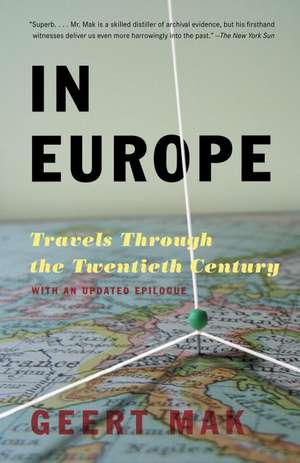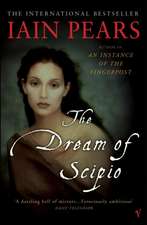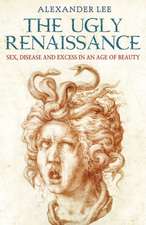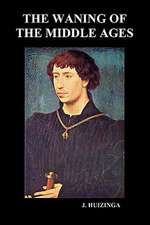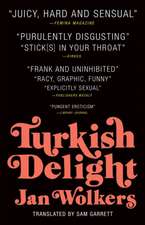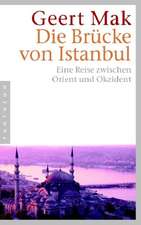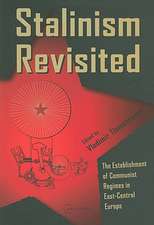In Europe: Travels Through the Twentieth Century
Autor Geert Mak Traducere de Sam Garretten Limba Engleză Paperback – 31 mai 2008
Preț: 161.48 lei
Nou
Puncte Express: 242
Preț estimativ în valută:
30.90€ • 31.92$ • 25.72£
30.90€ • 31.92$ • 25.72£
Carte indisponibilă temporar
Doresc să fiu notificat când acest titlu va fi disponibil:
Se trimite...
Preluare comenzi: 021 569.72.76
Specificații
ISBN-13: 9780307280572
ISBN-10: 0307280578
Pagini: 878
Dimensiuni: 132 x 204 x 37 mm
Greutate: 0.84 kg
Ediția:Reprint
Editura: Vintage Books USA
ISBN-10: 0307280578
Pagini: 878
Dimensiuni: 132 x 204 x 37 mm
Greutate: 0.84 kg
Ediția:Reprint
Editura: Vintage Books USA
Notă biografică
Geert Mak is one of The Netherlands' most popular writers. All his previous books became huge bestsellers: De engel van Amsterdam (The Angel of Amsterdam, 1992), Een kleine geschiedenis van Amsterdam (Amsterdam: A Brief Life of the City, 1994), Hoe God verdween uit Jorwerd (Jorwerd: The Death of the Village in late Twentieth-century Europe, 1996), and De eeuw van mijn vader (My Father's Century, 1999).
Extras
Chapter One: Amsterdam
When I left Amsterdam on Monday morning, 4 January, 1999, a storm was rampaging through the town. The wind made ripples on the watery cobblestones, white horses on the River IJ, and whistled beneath the high iron roof of Central Station. For a moment I thought that God’s hand had momentarily tilted up all that iron, then set it back in place.
I was dragging my big, black suitcase. In it was a laptop, a mobile phone I could use to dispatch my daily columns, a few shirts, a sponge bag, a CD-ROM of the Encyclopaedia Britannica, and at least fifteen books to soothe my nerves. My plan was to begin with the baroque cities of 1900, with the lightness of the Paris World’s Fair, with Queen Victoria’s reign over an empire of certainties, with the upsurge of Berlin.
The air was full of noises: the slapping of the waves, the crying of gulls on the wind, the roaring of the storm through the bare treetops, the trams, the traffic. There was very little light. The clouds chased across the sky from west to east, like dark-grey riders. For a moment they wafted a few notes along with them, the floating single strokes of a carillon. The newspapers reported that Morse code had now been phased out completely, and that the slipstreams of low-flying Ilyushins at Oostend airbase regularly sucked tiles off the neighbouring roofs. On the financial markets, the euro had made a brilliant debut. ‘Euro kicks off with challenge to dollar’s hegemony’ was Le Monde’s headline, and that morning the currency had briefly risen as high as $1.19. But Holland that day was ruled by the wind, the last, untamed force that left its mark in all directions, north-east, south-west, a persistent slamming that had shaped the lakes and polders, the course of canals, the dykes, the roads and even the railway track along which I rode south, into the wet polder landscape.
The boy with the blue tie and the pleasant face sitting beside me snapped open his computer right away, conjured up a whole series of spreadsheets and began phoning his colleagues. His name was Peter Smithuis. ‘The Germans want a hundred per cent solution, the other Europeans only need seventy-five,’ he spoke into the void. ‘What we can do now is look for something like a seventy-five-plus option, and neutralise the Germans by putting them back at a hundred per cent anyway . . . Oh, mmm. Off stream since July? Be careful, you know how it goes, if we let them decide too fast, everything will grind to a halt.’
The rain clattered against the windows of the compartment, under the Moerdijk Bridge the ships danced on the waves, at Zevenbergen a tree was in very early blossom, a thousand red dots in the water. Beyond Roosendaal the pylons became rusty, the only trace of a border between prim Holland and the rest of Europe.
Before I had left I had a long talk with the oldest Dutchman I knew. Of all the people I spoke to that year, he was the only one who had lived through the entire century (with the exception of Alexandra Vasilyeva, that is, who was born in 1897 and had actually seen the czar and made her glorious stage debut at the Mariinsky theatre).
His name was Marinus van der Goes van Naters, but people called him ‘the Red nobleman’. He was born in 1900 and had once played a prominent role in the Dutch Social Democratic Party.
He told me about Nijmegen, where, when he was growing up, a total of two cars cruised the streets: one De Dion-Bouton and one Spijker, both handcrafted down to the last detail. ‘My brother and I would run to the window whenever one of them came by.’ He had never been particularly fond of those first car owners. ‘They were the same people you see these days talking into portable telephones.’
On class relations: ‘At a certain point we became completely enraptured by the new social order that was on its way. We wanted to talk to a worker, but we didn’t know any. Through acquaintances of an acquaintance we finally met a worker’s wife, who read something aloud to us from a newspaper. I still wonder why, if we wanted to meet one so badly, we didn’t just go up to a worker on the street and talk to him!’
On technology: ‘My friend and I were always fascinated by the phenomenon of electricity. We had read an adventure novel that talked about a machine you could use to talk to people without wires, no matter how far away they were. That seemed unbelievable to us. We installed lights, built telephones we could use to talk to each other two rooms away, we made sparks fly, we invented things, real inventions!’
My host took a book down from the shelf, its pages loose with age and use. Edward Bellamy, In het jaar 2000, Amsterdam 1890. ‘This is what we talked about, things like this.’ The story is a simple one: a nineteenth-century man falls into a deep sleep after being hypnotised and does not wake up until the year 2000. He finds himself in a city full of statues, fountains, covered walkways, gentlemen in top hats, ladies in evening dress. Thanks to electrical light, there is no more darkness. Night has been banished. Every home has a listening device, connected by an open telephone line to one of the municipal concert halls.
‘Here, read what one of those twentieth-century creatures says here: “At home we have comfort, but we seek the glory of life within society itself.” That was the kind of world we were looking for, in the year 2000. Money would no longer play any role. Every citizen would be safeguarded against “hunger, cold and nakedness”, products and services would be exchanged by means of an ingenious credit system, food prepared in huge, communal restaurants and delivered, if need be, by tube mail. The boys would be “sturdy”, the girls “fresh and strong”, the sexes would be free and informal in their dealings with each other, private shops would disappear, there would be no more advertising, publishing houses would be collectivised, newspaper editors would be elected by their readers, criminality and greed abolished, and – read for yourself – even the “crudest of individuals” would adopt “the comportment of the civilised classes”. Here, this passage: “Kneeling, my countenance bowed to the earth, I confessed in tears my unworthiness to breathe the air of this golden age. The long and sorrowful winter of mankind has come to an end. The heavens have opened to us.” What a book!’
The wintry light fell on the yellowed wallpaper of the study, the faded books on the shelf, the standing lamp with its cloth shade and tassels, my host’s strong hands, slightly spotted skin, his clear eyes.
‘What do I think about this century, now that it’s over? Ah, a century is only a mathematical construct, a human fantasy, isn’t it? Back then I thought in terms of months, a year at the most. Now I think in twenty-year spans, that seems like nothing to me any more. Growing so immoderately old spoils one. Time no longer fazes you . . .’
Chapter Two: Paris
The new century was a woman, they were all in agreement on that back in 1900. Take, for example, the drawing on the cover of the piano music for the English song ‘Dawn of the Century’, a ‘march & two step’ by one E. M. Paul. Amid golden clouds a woman balances on a winged wheel, around her float a tram, a typewriter, a telephone, a sewing machine, a camera, a harvester, a railway engine and, at the bottom of the picture, there is even a car turning the corner.
The European metropolises were feminine as well, if only in the lavish shapes of the thousands of little palaces of the bourgeoisie along the new boulevards and residential streets, with their curlicues and garlands in every ‘neo’ style imaginable, a ruttish profusion still found from Berlin to Barcelona.
So too the cover of the catalogue for the 1900 Paris World’s Fair: a woman, of course, a rather hefty one this time, her hair blowing in the wind, a banner in her hand. Above the gate to the fairgrounds, a plaster woman six metres tall, in a wide cloak and evening dress by the couturier Paquin. At the official opening, Émile Loubet, the French president, spoke of the virtues of the new century: justice and human kindness. His minister of employment expected even more good things: gentleness and solidarity.
The fifty million visitors traipsed from one miracle to the next. There were X-ray machines with which you could look right through men and women, there was an automobile exhibition, there was equipment for wireless telegraphy, and from outside the gates one could catch the first underground line of Le Métro, built in less than eighteen months from Porte de Vincennes to Porte Maillot. Forty countries took part. California had dug an imitation gold mine, Egypt came with a temple and an antique tomb, Great Britain showed off all the colonies of its empire, Germany had a steam locomotive that could travel at 120 kph. France exhibited a model of Clément Ader’s motorised flying machine, a gigantic bat with a thirty-metre wingspan; humans, after all, were destined to leave the earth one day.
There was a Dance Palace where a wide variety of ballets were performed, a Grand Palais full of French paintings and sculpture, and a building where the visitor could ‘travel’ around the entire world on a special ceiling for two francs, from the blossoming orchards of Japan by way of the Acropolis to the coasts of Spain, all depicted with extreme skill by the painter Dumoulin and his team. There was a cineorama, a variation on the panorama, where one could revel in the view from an airship or a compartment aboard the Trans-Siberian Express. The military section displayed the newest technologies in warfare: the machine gun, the torpedo, the gun turret, wireless telegraphy equipment, the personnel carrier. And completely new were the shows at the phono-cinema theatre, with newsreels accompanied by a phonograph recording. Among other things, the shaky images filmed by the Pathé Brothers showed – extra! – the Rostand family in their box at the premiere of L’Aiglon, and other sensations of the day: the test flight of Graf Zeppelin’s first airship, the opening of a railway line through Africa, new cotton mills in Manchester, victorious Englishmen in the course of the Boer War, a speech by the kaiser, the launching of a battle cruiser.
The map in the catalogue provides a bird’s-eye view of the impressive fair grounds: from the Grand Palais, along the lanes of pavilions on both banks of the Seine, to the Eiffel Tower and the great exhibition halls on the Champ de Mars. The World’s Fair was a part of the city as a whole. Or, put differently, Paris with its boulevards laid out from 1853 under the prefecture of Georges Haussmann blended seamlessly with the fair, because Paris had become a permanent exhibition in itself, the grand display window of France, the city state of the new century. And both – as the photographs in the catalogue also show – were created for the new urbanite par excellence, the boulevardier, the actor/viewer of the theatre of the street, the young people on an allowance, the noble property owner, the wealthy officer, the youthful bourgeois relieved of all financial concerns.
‘The weather is so warm, so lovely, that I go outside again after dinner, even though I feel fatigue coming on,’ noted the young writer André Gide in the summer of 1905. ‘First along the Champs-Élysées, strutting past the cafés-concerts, I bustle through to the rotunda, then turn back along the Élysées again; the crowd is partying, in greater numbers and with greater cheer, all the way to the rue Royale.’
On other days he rides the roof rack of an omnibus, walks in the Bois de Boulogne, visits the opera, then heads back to a new exhibition featuring Gauguin, Van Gogh and Cézanne, ‘impossible not to visit the Louvre these days’.
The boulevardier’s haven was the café, the marble table with kirsch and hot chocolate and friends all around, the democratic successor to the aristocratic salon. His prime trait was an infallible sense of timing: to be found in the best establishment at the best moment. The urban stroller moved between the old age and the new, plunging into the anonymity of the crowd, then falling back into the old security of one’s own class. It was a way of life that showed up everywhere in the literature of the day, a modern courtliness that conquered every major European city.
André Gide, 1 September, 1905: ‘I am swept off my feet, I let myself be carried along by this monotone flow, dragged along by the course of the days. A great lethargy overtakes me, from the moment I arise to the evening hour; the game saves me at times, but gradually I lose my normal life.’
I stroll from the Champ de Mars along the Seine and the roaring traffic on both banks to the boarded-up entrance of the Grand Palais, which is now being restored. Big neon letters on the Eiffel Tower read ‘347 days till the year 2000’. Of the old World’s Fair, the Grand Palais and the Petit Palais are still standing, and of course the Pont Alexandre III, with its four pillars at the corners, gigantic golden horses atop those, and along the edges a lacework of bronze lanterns with glass like cut diamonds.
In that same April in which the Pont Alexandre III and the 1900 World’s Fair were opened, the anti-Semitic daily La Libre Parole took up a collection to present a pair of rapiers to the Jew-hater Raphaël Viau, to commemorate his twelfth duel ‘for the good cause’. Viau expressed his hope that the blades ‘would not long remain unsullied’.
Around the turn of the century, three major scandals rocked Europe’s capitals. They were cracks in the façade, the first fissures in that steadfast world of rank and class. In London, in 1895, there was the conviction of the brilliant writer Oscar Wilde for perversity. In Berlin, a similar scandal took place in the period 1907–9 concerning Prince Philipp zu Eulenburg, former ambassador to Vienna and one of the German emperor’s intimate friends. But the scandal with the greatest impact was the Dreyfus affair.
No other issue occupied the French more intensely between 1897–9 than the possible rehabilitation of the unjustly accused Alfred Dreyfus. This Jewish army captain had been banished to Devil’s Island for allegedly having spied for the Germans. Gradually, however, it became increasingly clear that officers of the war council had tampered with his dossier and then, to refute the rising groundswell of suspicion, had continued to pile forgery upon forgery. The nation’s military command knew about it, but refused to budge. To admit to such fraud would be tantamount to blasphemy, and would cast a taint on the gloire militaire.
From the Hardcover edition.
When I left Amsterdam on Monday morning, 4 January, 1999, a storm was rampaging through the town. The wind made ripples on the watery cobblestones, white horses on the River IJ, and whistled beneath the high iron roof of Central Station. For a moment I thought that God’s hand had momentarily tilted up all that iron, then set it back in place.
I was dragging my big, black suitcase. In it was a laptop, a mobile phone I could use to dispatch my daily columns, a few shirts, a sponge bag, a CD-ROM of the Encyclopaedia Britannica, and at least fifteen books to soothe my nerves. My plan was to begin with the baroque cities of 1900, with the lightness of the Paris World’s Fair, with Queen Victoria’s reign over an empire of certainties, with the upsurge of Berlin.
The air was full of noises: the slapping of the waves, the crying of gulls on the wind, the roaring of the storm through the bare treetops, the trams, the traffic. There was very little light. The clouds chased across the sky from west to east, like dark-grey riders. For a moment they wafted a few notes along with them, the floating single strokes of a carillon. The newspapers reported that Morse code had now been phased out completely, and that the slipstreams of low-flying Ilyushins at Oostend airbase regularly sucked tiles off the neighbouring roofs. On the financial markets, the euro had made a brilliant debut. ‘Euro kicks off with challenge to dollar’s hegemony’ was Le Monde’s headline, and that morning the currency had briefly risen as high as $1.19. But Holland that day was ruled by the wind, the last, untamed force that left its mark in all directions, north-east, south-west, a persistent slamming that had shaped the lakes and polders, the course of canals, the dykes, the roads and even the railway track along which I rode south, into the wet polder landscape.
The boy with the blue tie and the pleasant face sitting beside me snapped open his computer right away, conjured up a whole series of spreadsheets and began phoning his colleagues. His name was Peter Smithuis. ‘The Germans want a hundred per cent solution, the other Europeans only need seventy-five,’ he spoke into the void. ‘What we can do now is look for something like a seventy-five-plus option, and neutralise the Germans by putting them back at a hundred per cent anyway . . . Oh, mmm. Off stream since July? Be careful, you know how it goes, if we let them decide too fast, everything will grind to a halt.’
The rain clattered against the windows of the compartment, under the Moerdijk Bridge the ships danced on the waves, at Zevenbergen a tree was in very early blossom, a thousand red dots in the water. Beyond Roosendaal the pylons became rusty, the only trace of a border between prim Holland and the rest of Europe.
Before I had left I had a long talk with the oldest Dutchman I knew. Of all the people I spoke to that year, he was the only one who had lived through the entire century (with the exception of Alexandra Vasilyeva, that is, who was born in 1897 and had actually seen the czar and made her glorious stage debut at the Mariinsky theatre).
His name was Marinus van der Goes van Naters, but people called him ‘the Red nobleman’. He was born in 1900 and had once played a prominent role in the Dutch Social Democratic Party.
He told me about Nijmegen, where, when he was growing up, a total of two cars cruised the streets: one De Dion-Bouton and one Spijker, both handcrafted down to the last detail. ‘My brother and I would run to the window whenever one of them came by.’ He had never been particularly fond of those first car owners. ‘They were the same people you see these days talking into portable telephones.’
On class relations: ‘At a certain point we became completely enraptured by the new social order that was on its way. We wanted to talk to a worker, but we didn’t know any. Through acquaintances of an acquaintance we finally met a worker’s wife, who read something aloud to us from a newspaper. I still wonder why, if we wanted to meet one so badly, we didn’t just go up to a worker on the street and talk to him!’
On technology: ‘My friend and I were always fascinated by the phenomenon of electricity. We had read an adventure novel that talked about a machine you could use to talk to people without wires, no matter how far away they were. That seemed unbelievable to us. We installed lights, built telephones we could use to talk to each other two rooms away, we made sparks fly, we invented things, real inventions!’
My host took a book down from the shelf, its pages loose with age and use. Edward Bellamy, In het jaar 2000, Amsterdam 1890. ‘This is what we talked about, things like this.’ The story is a simple one: a nineteenth-century man falls into a deep sleep after being hypnotised and does not wake up until the year 2000. He finds himself in a city full of statues, fountains, covered walkways, gentlemen in top hats, ladies in evening dress. Thanks to electrical light, there is no more darkness. Night has been banished. Every home has a listening device, connected by an open telephone line to one of the municipal concert halls.
‘Here, read what one of those twentieth-century creatures says here: “At home we have comfort, but we seek the glory of life within society itself.” That was the kind of world we were looking for, in the year 2000. Money would no longer play any role. Every citizen would be safeguarded against “hunger, cold and nakedness”, products and services would be exchanged by means of an ingenious credit system, food prepared in huge, communal restaurants and delivered, if need be, by tube mail. The boys would be “sturdy”, the girls “fresh and strong”, the sexes would be free and informal in their dealings with each other, private shops would disappear, there would be no more advertising, publishing houses would be collectivised, newspaper editors would be elected by their readers, criminality and greed abolished, and – read for yourself – even the “crudest of individuals” would adopt “the comportment of the civilised classes”. Here, this passage: “Kneeling, my countenance bowed to the earth, I confessed in tears my unworthiness to breathe the air of this golden age. The long and sorrowful winter of mankind has come to an end. The heavens have opened to us.” What a book!’
The wintry light fell on the yellowed wallpaper of the study, the faded books on the shelf, the standing lamp with its cloth shade and tassels, my host’s strong hands, slightly spotted skin, his clear eyes.
‘What do I think about this century, now that it’s over? Ah, a century is only a mathematical construct, a human fantasy, isn’t it? Back then I thought in terms of months, a year at the most. Now I think in twenty-year spans, that seems like nothing to me any more. Growing so immoderately old spoils one. Time no longer fazes you . . .’
Chapter Two: Paris
The new century was a woman, they were all in agreement on that back in 1900. Take, for example, the drawing on the cover of the piano music for the English song ‘Dawn of the Century’, a ‘march & two step’ by one E. M. Paul. Amid golden clouds a woman balances on a winged wheel, around her float a tram, a typewriter, a telephone, a sewing machine, a camera, a harvester, a railway engine and, at the bottom of the picture, there is even a car turning the corner.
The European metropolises were feminine as well, if only in the lavish shapes of the thousands of little palaces of the bourgeoisie along the new boulevards and residential streets, with their curlicues and garlands in every ‘neo’ style imaginable, a ruttish profusion still found from Berlin to Barcelona.
So too the cover of the catalogue for the 1900 Paris World’s Fair: a woman, of course, a rather hefty one this time, her hair blowing in the wind, a banner in her hand. Above the gate to the fairgrounds, a plaster woman six metres tall, in a wide cloak and evening dress by the couturier Paquin. At the official opening, Émile Loubet, the French president, spoke of the virtues of the new century: justice and human kindness. His minister of employment expected even more good things: gentleness and solidarity.
The fifty million visitors traipsed from one miracle to the next. There were X-ray machines with which you could look right through men and women, there was an automobile exhibition, there was equipment for wireless telegraphy, and from outside the gates one could catch the first underground line of Le Métro, built in less than eighteen months from Porte de Vincennes to Porte Maillot. Forty countries took part. California had dug an imitation gold mine, Egypt came with a temple and an antique tomb, Great Britain showed off all the colonies of its empire, Germany had a steam locomotive that could travel at 120 kph. France exhibited a model of Clément Ader’s motorised flying machine, a gigantic bat with a thirty-metre wingspan; humans, after all, were destined to leave the earth one day.
There was a Dance Palace where a wide variety of ballets were performed, a Grand Palais full of French paintings and sculpture, and a building where the visitor could ‘travel’ around the entire world on a special ceiling for two francs, from the blossoming orchards of Japan by way of the Acropolis to the coasts of Spain, all depicted with extreme skill by the painter Dumoulin and his team. There was a cineorama, a variation on the panorama, where one could revel in the view from an airship or a compartment aboard the Trans-Siberian Express. The military section displayed the newest technologies in warfare: the machine gun, the torpedo, the gun turret, wireless telegraphy equipment, the personnel carrier. And completely new were the shows at the phono-cinema theatre, with newsreels accompanied by a phonograph recording. Among other things, the shaky images filmed by the Pathé Brothers showed – extra! – the Rostand family in their box at the premiere of L’Aiglon, and other sensations of the day: the test flight of Graf Zeppelin’s first airship, the opening of a railway line through Africa, new cotton mills in Manchester, victorious Englishmen in the course of the Boer War, a speech by the kaiser, the launching of a battle cruiser.
The map in the catalogue provides a bird’s-eye view of the impressive fair grounds: from the Grand Palais, along the lanes of pavilions on both banks of the Seine, to the Eiffel Tower and the great exhibition halls on the Champ de Mars. The World’s Fair was a part of the city as a whole. Or, put differently, Paris with its boulevards laid out from 1853 under the prefecture of Georges Haussmann blended seamlessly with the fair, because Paris had become a permanent exhibition in itself, the grand display window of France, the city state of the new century. And both – as the photographs in the catalogue also show – were created for the new urbanite par excellence, the boulevardier, the actor/viewer of the theatre of the street, the young people on an allowance, the noble property owner, the wealthy officer, the youthful bourgeois relieved of all financial concerns.
‘The weather is so warm, so lovely, that I go outside again after dinner, even though I feel fatigue coming on,’ noted the young writer André Gide in the summer of 1905. ‘First along the Champs-Élysées, strutting past the cafés-concerts, I bustle through to the rotunda, then turn back along the Élysées again; the crowd is partying, in greater numbers and with greater cheer, all the way to the rue Royale.’
On other days he rides the roof rack of an omnibus, walks in the Bois de Boulogne, visits the opera, then heads back to a new exhibition featuring Gauguin, Van Gogh and Cézanne, ‘impossible not to visit the Louvre these days’.
The boulevardier’s haven was the café, the marble table with kirsch and hot chocolate and friends all around, the democratic successor to the aristocratic salon. His prime trait was an infallible sense of timing: to be found in the best establishment at the best moment. The urban stroller moved between the old age and the new, plunging into the anonymity of the crowd, then falling back into the old security of one’s own class. It was a way of life that showed up everywhere in the literature of the day, a modern courtliness that conquered every major European city.
André Gide, 1 September, 1905: ‘I am swept off my feet, I let myself be carried along by this monotone flow, dragged along by the course of the days. A great lethargy overtakes me, from the moment I arise to the evening hour; the game saves me at times, but gradually I lose my normal life.’
I stroll from the Champ de Mars along the Seine and the roaring traffic on both banks to the boarded-up entrance of the Grand Palais, which is now being restored. Big neon letters on the Eiffel Tower read ‘347 days till the year 2000’. Of the old World’s Fair, the Grand Palais and the Petit Palais are still standing, and of course the Pont Alexandre III, with its four pillars at the corners, gigantic golden horses atop those, and along the edges a lacework of bronze lanterns with glass like cut diamonds.
In that same April in which the Pont Alexandre III and the 1900 World’s Fair were opened, the anti-Semitic daily La Libre Parole took up a collection to present a pair of rapiers to the Jew-hater Raphaël Viau, to commemorate his twelfth duel ‘for the good cause’. Viau expressed his hope that the blades ‘would not long remain unsullied’.
Around the turn of the century, three major scandals rocked Europe’s capitals. They were cracks in the façade, the first fissures in that steadfast world of rank and class. In London, in 1895, there was the conviction of the brilliant writer Oscar Wilde for perversity. In Berlin, a similar scandal took place in the period 1907–9 concerning Prince Philipp zu Eulenburg, former ambassador to Vienna and one of the German emperor’s intimate friends. But the scandal with the greatest impact was the Dreyfus affair.
No other issue occupied the French more intensely between 1897–9 than the possible rehabilitation of the unjustly accused Alfred Dreyfus. This Jewish army captain had been banished to Devil’s Island for allegedly having spied for the Germans. Gradually, however, it became increasingly clear that officers of the war council had tampered with his dossier and then, to refute the rising groundswell of suspicion, had continued to pile forgery upon forgery. The nation’s military command knew about it, but refused to budge. To admit to such fraud would be tantamount to blasphemy, and would cast a taint on the gloire militaire.
From the Hardcover edition.
Recenzii
“Superb. . . . Mr. Mak is a skilled distiller of archival evidence, but his firsthand witnesses deliver us even more harrowingly into the past.”—The New York Sun“An original, fresh and first-hand documented essay of recent European history. It's an ideal reading for anyone doing 'le grand tour' across the Old Continent.”—The Washington Post“Dazzling, imaginative and mesmerizing.”—The Tucson Citizen “Subtle. . . It is a testament to Mak's warmth and skill as a writer that even in a chronicle of unrelenting barbarity he has portrayed a humanity worth saving.”—Time
Descriere
Descriere de la o altă ediție sau format:
Geert Mak spent the year 1999 criss-crossing the continent, tracing the history of Europe from Verdun to Berlin, St Petersburg to Auschwitz, Kiev to Srebrenica.
Geert Mak spent the year 1999 criss-crossing the continent, tracing the history of Europe from Verdun to Berlin, St Petersburg to Auschwitz, Kiev to Srebrenica.
